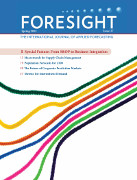Editor Len Tashman's Preview of the Spring issue of Foresight

The Special Feature article of this 37th issue of Foresight – From Sales and Operations Planning to Business Integration – comes about through a rare but effective collaboration between an academic and a practitioner. The coauthors are Mark Moon, head of the Department of Marketing and Supply Chain Management at the University of Tennessee, Knoxville and author of Demand and Supply Integration: The Key to World-Class Demand Forecasting, and Pete Alle, Vice President of Supply Chain for Oberweis Dairy and overseer of global process improvement and innovation across that company’s supply chain.
The article identifies the failings of organizational implementations of S&OP, including (a) planning horizons that are too short-term, (b) a process driven by the supply chain, and (c) a retrospective rather than forward-looking agenda in the monthly planning meetings.
To effectively drive business integration, the authors argue, changes may be required in organizational structure, processes, and culture, with leadership commitments, employee incentive structures, and training comprising critical components.
Next up is our section on Strategic Forecasting, which looks outside our immediate planning fences. Businesses too often have only a short-term focus in their planning and operations, taking a reactive posture to crises in their supply chains while failing to consider and manage events that present important risks and opportunities. So argue Tom Goldsby, Chad Autry, and John Bell, the authors of Thinking Big! Incorporating Macrotrends into Supply Chain Planning and Execution. They examine four key macrotrends and describe their potentially profound effects on corporate supply chains. These macrotrends are (1) global population growth and shifts, (2) interconnectedness and social leveling, (3) climate change and sustainability, and (4) resource scarcity and conflicts.
Forecasts of global population growth are a lynchpin for strategic planning, but it’s a questionable assumption that even official forecasts can be considered reliable. In The United Nations Probabilistic Population Projections: An Introduction to Demographic Forecasting with Uncertainty, noted population-forecasting experts Leontine Alkema, Patrick Gerland, Adrian E. Raftery, and John R. Wilmoth describe the state of the art here in providing margins of error around the best point forecasts. Their examples show just how wide the area of uncertainty is, providing a cautionary note to long-range forecasters and strategic planners.
Have Corporate Prediction Markets Had Their Heyday? Despite great acclaim for the potential of prediction markets as an efficient tool for aggregating individual judgments, corporate adoption has been limited. To find out why, Thomas Wolfram examined existing research and interviewed several dozen key business executives. He reports that problems with overall acceptance of the corporate prediction market (CPM) often stem from a lack of trust by management as well as a greater business focus these days on big data and social media content. Hope for the CPM persists, though – if certain obstacles can be finessed.
Intermittent demands have been a bugaboo for corporate forecasters, and numerous articles have been published – several in Foresight – that show how to make the best of a very difficult methodological challenge. An important aspect of the problem is the basis upon which we choose a “best” forecasting method. In his new article Measuring the Quality of Intermittent-Demand Forecasts: It’s Worse than We’ve Thought, Steve Morlidge clearly demonstrates that we must rethink the use of our most common accuracy metrics for selecting that optimal forecast method. The problem is acute, he writes, because many software applications use these metrics for performance evaluation and method selection; in doing so, they potentially provide us with poor feedback and inferior models, resulting in harmful consequences for inventory management.
Steve evaluates various metrics that have been offered to assess the performance of intermittent-demand models and proposes a bias-adjusted error metric that may be superior to its predecessors.

Our book review in this issue examines a new text that seeks to integrate demand forecasting with inventory management: Demand Forecasting for Inventory Control by Nick T. Thomopoulos, Professor Emeritus of the Illinois Institute of Technology. Reviewer Stephan Kolassa, Foresight’s Associate Editor, presents the high hopes he had for the book and goes on to frankly discuss his likes and misgivings.
This Spring 2015 issue concludes with our latest Forecaster in the Field interview, introducing Fotios Petropoulos, Foresight’s new Editor for Forecasting Support Systems. Fotios will be speaking at the upcoming International Symposium on Forecasting (ISF) on ways forward for our forecasting support systems, part of Foresight’s…
Forecasting in Practice Track
The 35th annual ISF will be held in Riverside, California from June 21-24. Riverside was rated America’s eighth coolest city in a Forbes survey last year.
For the past three and a half decades, the ISF has been the principal forum for presentation of new research on forecasting methods and practices, bringing together researchers and practitioners from more than 30 countries around the world. View the 2015 program and its speakers at www.forecasters.org/isf/.
An integral part of this year’s ISF is the Forecasting in Practice track. The nine speakers in this track will examine forecasting and planning processes, and offer proposals for upgrading our forecasting performance:
- Sustaining a Collaborative Forecasting Process Simon Clarke, Coca-Cola Refreshments
- Improving Forecast Quality in Practice Robert Fildes, Lancaster University
- Managing Supply Chains in a Digital Interconnected Economy Ram Ganeshan, College of William and Mary
- Role of the Sales Force in Forecasting Michael Gilliland, SAS Institute, Inc.
- Macro Trends and Their Implications for Supply Chain Management Thomas Goldsby, The Ohio State University
- Harnessing your Judgment to Achieve Greater Forecast Accuracy Paul Goodwin, University of Bath
- Strategies for Demand and Supply Integration John Mello, Arkansas State University
- Managing the Performance of a Forecasting Process Steve Morlidge, Satori Partners
- Forecasting Support Systems: Ways Forward Fotios Petropoulos, Cardiff University
